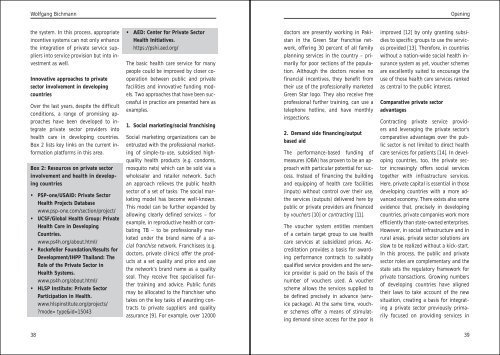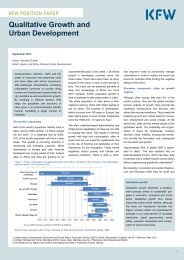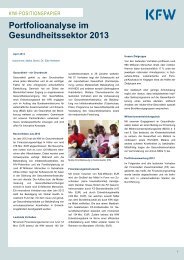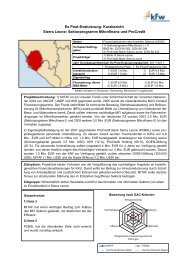Making partnerships work for health, focusing on low-income countries
Making partnerships work for health, focusing on low-income countries
Making partnerships work for health, focusing on low-income countries
You also want an ePaper? Increase the reach of your titles
YUMPU automatically turns print PDFs into web optimized ePapers that Google loves.
Wolfgang Bichmann Opening<br />
the system. In this process, appropriate<br />
incentive systems can not <strong>on</strong>ly enhance<br />
the integrati<strong>on</strong> of private service suppliers<br />
into service provisi<strong>on</strong> but into investment<br />
as well.<br />
Innovative approaches to private<br />
sector involvement in developing<br />
<strong>countries</strong><br />
Over the last years, despite the difficult<br />
c<strong>on</strong>diti<strong>on</strong>s, a range of promising approaches<br />
have been developed to integrate<br />
private sector providers into<br />
<str<strong>on</strong>g>health</str<strong>on</strong>g> care in developing <strong>countries</strong>.<br />
Box 2 lists key links <strong>on</strong> the current in<str<strong>on</strong>g>for</str<strong>on</strong>g>mati<strong>on</strong><br />
plat<str<strong>on</strong>g>for</str<strong>on</strong>g>ms in this area.<br />
Box 2: Resources <strong>on</strong> private sector<br />
involvement and <str<strong>on</strong>g>health</str<strong>on</strong>g> in developing<br />
<strong>countries</strong><br />
PSP-<strong>on</strong>e/USAID: Private Sector<br />
Health Projects Database<br />
www.psp-<strong>on</strong>e.com/secti<strong>on</strong>/project/<br />
UCSF/Global Health Group: Private<br />
Health Care in Developing<br />
Countries.<br />
www.ps4h.org/about.html/<br />
Rockefeller Foundati<strong>on</strong>/Results <str<strong>on</strong>g>for</str<strong>on</strong>g><br />
Development/IHPP Thailand: The<br />
Role of the Private Sector in<br />
Health Systems.<br />
www.ps4h.org/about.html/<br />
HLSP Institute: Private Sector<br />
Participati<strong>on</strong> in Health.<br />
www.hlspinstitute.org/projects/<br />
?mode= type&id=15043<br />
AED: Center <str<strong>on</strong>g>for</str<strong>on</strong>g> Private Sector<br />
Health Initiatives.<br />
https://pshi.aed.org/<br />
The basic <str<strong>on</strong>g>health</str<strong>on</strong>g> care service <str<strong>on</strong>g>for</str<strong>on</strong>g> many<br />
people could be improved by closer cooperati<strong>on</strong><br />
between public and private<br />
facilities and innovative funding models.<br />
Two approaches that have been successful<br />
in practice are presented here as<br />
examples.<br />
1. Social marketing/social franchising<br />
Social marketing organizati<strong>on</strong>s can be<br />
entrusted with the professi<strong>on</strong>al marketing<br />
of simple-to-use, subsidised highquality<br />
<str<strong>on</strong>g>health</str<strong>on</strong>g> products (e.g. c<strong>on</strong>doms,<br />
mosquito nets) which can be sold via a<br />
wholesaler and retailer net<str<strong>on</strong>g>work</str<strong>on</strong>g>. Such<br />
an approach relieves the public <str<strong>on</strong>g>health</str<strong>on</strong>g><br />
sector of a set of tasks. The social marketing<br />
model has become well-known.<br />
This model can be further expanded by<br />
al<strong>low</strong>ing clearly defined services – <str<strong>on</strong>g>for</str<strong>on</strong>g><br />
example, in reproductive <str<strong>on</strong>g>health</str<strong>on</strong>g> or combating<br />
TB – to be professi<strong>on</strong>ally marketed<br />
under the brand name of a social<br />
franchise net<str<strong>on</strong>g>work</str<strong>on</strong>g>. Franchisees (e.g.<br />
doctors, private clinics) offer the products<br />
at a set quality and price and use<br />
the net<str<strong>on</strong>g>work</str<strong>on</strong>g>‘s brand name as a quality<br />
seal. They receive free specialised further<br />
training and advice. Public funds<br />
may be allocated to the franchiser who<br />
takes <strong>on</strong> the key tasks of awarding c<strong>on</strong>tracts<br />
to private suppliers and quality<br />
assurance [9]. For example, over 12000<br />
doctors are presently <str<strong>on</strong>g>work</str<strong>on</strong>g>ing in Pakistan<br />
in the Green Star franchise net<str<strong>on</strong>g>work</str<strong>on</strong>g>,<br />
offering 30 percent of all family<br />
planning services in the country – primarily<br />
<str<strong>on</strong>g>for</str<strong>on</strong>g> poor secti<strong>on</strong>s of the populati<strong>on</strong>.<br />
Although the doctors receive no<br />
financial incentives, they benefit from<br />
their use of the professi<strong>on</strong>ally marketed<br />
Green Star logo. They also receive free<br />
professi<strong>on</strong>al further training, can use a<br />
teleph<strong>on</strong>e hotline, and have m<strong>on</strong>thly<br />
inspecti<strong>on</strong>s.<br />
2. Demand side financing/output<br />
based aid<br />
The per<str<strong>on</strong>g>for</str<strong>on</strong>g>mance-based funding of<br />
measures (OBA) has proven to be an approach<br />
with particular potential <str<strong>on</strong>g>for</str<strong>on</strong>g> success.<br />
Instead of financing the building<br />
and equipping of <str<strong>on</strong>g>health</str<strong>on</strong>g> care facilities<br />
(inputs) without c<strong>on</strong>trol over their use,<br />
the services (outputs) delivered here by<br />
public or private providers are financed<br />
by vouchers [10] or c<strong>on</strong>tracting [11].<br />
The voucher system entitles members<br />
of a certain target group to use <str<strong>on</strong>g>health</str<strong>on</strong>g><br />
care services at subsidized prices. Accreditati<strong>on</strong><br />
provides a basis <str<strong>on</strong>g>for</str<strong>on</strong>g> awarding<br />
per<str<strong>on</strong>g>for</str<strong>on</strong>g>mance c<strong>on</strong>tracts to suitably<br />
qualified service providers and the service<br />
provider is paid <strong>on</strong> the basis of the<br />
number of vouchers used. A voucher<br />
scheme al<strong>low</strong>s the services supplied to<br />
be defined precisely in advance (service<br />
package). At the same time, voucher<br />
schemes offer a means of stimulating<br />
demand since access <str<strong>on</strong>g>for</str<strong>on</strong>g> the poor is<br />
improved [12] by <strong>on</strong>ly granting subsidies<br />
to specific groups to use the services<br />
provided [13]. There<str<strong>on</strong>g>for</str<strong>on</strong>g>e, in <strong>countries</strong><br />
without a nati<strong>on</strong>-wide social <str<strong>on</strong>g>health</str<strong>on</strong>g> insurance<br />
system as yet, voucher schemes<br />
are excellently suited to encourage the<br />
use of those <str<strong>on</strong>g>health</str<strong>on</strong>g> care services ranked<br />
as central to the public interest.<br />
Comparative private sector<br />
advantages<br />
C<strong>on</strong>tracting private service providers<br />
and leveraging the private sector‘s<br />
comparative advantages over the public<br />
sector is not limited to direct <str<strong>on</strong>g>health</str<strong>on</strong>g><br />
care services <str<strong>on</strong>g>for</str<strong>on</strong>g> patients [14]. In developing<br />
<strong>countries</strong>, too, the private sector<br />
increasingly offers social services<br />
together with infrastructure services.<br />
Here, private capital is essential in those<br />
developing <strong>countries</strong> with a more advanced<br />
ec<strong>on</strong>omy. There exists also some<br />
evidence that, precisely in developing<br />
<strong>countries</strong>, private companies <str<strong>on</strong>g>work</str<strong>on</strong>g> more<br />
efficiently than state-owned enterprises.<br />
However, in social infrastructure and in<br />
rural areas, private sector soluti<strong>on</strong>s are<br />
s<strong>low</strong> to be realized without a kick-start.<br />
In this process, the public and private<br />
sector roles are complementary and the<br />
state sets the regulatory frame<str<strong>on</strong>g>work</str<strong>on</strong>g> <str<strong>on</strong>g>for</str<strong>on</strong>g><br />
private transacti<strong>on</strong>s. Growing numbers<br />
of developing <strong>countries</strong> have aligned<br />
their laws to take account of the new<br />
situati<strong>on</strong>, creating a basis <str<strong>on</strong>g>for</str<strong>on</strong>g> integrating<br />
a private sector previously primarily<br />
focused <strong>on</strong> providing services in<br />
38 39












![Wasserversorgung Luang-Prabang I+II [2004] (PDF, 97 KB) - KfW ...](https://img.yumpu.com/21663442/1/184x260/wasserversorgung-luang-prabang-i-ii-2004-pdf-97-kb-kfw-.jpg?quality=85)
![Entwicklungsbank NDB I+II [2002] (PDF, 88 KB) - KfW ...](https://img.yumpu.com/21363284/1/184x260/entwicklungsbank-ndb-i-ii-2002-pdf-88-kb-kfw-.jpg?quality=85)


![Instandsetzung Baharia-Eisenbahnlinie I und II [2004] (PDF, 123 KB)](https://img.yumpu.com/21289660/1/184x260/instandsetzung-baharia-eisenbahnlinie-i-und-ii-2004-pdf-123-kb.jpg?quality=85)
